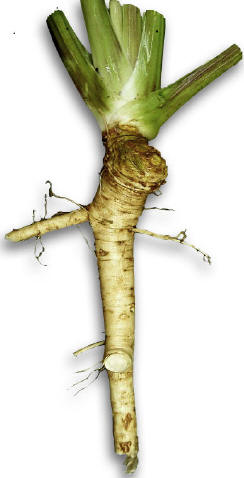|
Horseradish, Herb of the Year 2011
Madeline Wajda
Adams County Master Gardener
 Horseradish, (Armoracia rusticana) the tangy root, is the yearís International Herb Associationís selection as herb of the year. Why not? It is reported that the Oracle at Delphi told Apollo that horseradish was worth its weight in gold. Egyptians knew about it as long ago as 1500 BC. Horseradish, (Armoracia rusticana) the tangy root, is the yearís International Herb Associationís selection as herb of the year. Why not? It is reported that the Oracle at Delphi told Apollo that horseradish was worth its weight in gold. Egyptians knew about it as long ago as 1500 BC.
It is one of the five bitter herbs Jewish people eat at Passover. Early Greeks used ground horseradish as a rub for lower back pain, a very effective diuretic, and a cure for rheumatism. Originally a wild-crafted plant in eastern Europe, horseradish has been used to put zing in dishes for time out of memory. It is high in vitamin C and has anti-microbial properties
to preserve meat.
 Through most of the sixteenth century it was used only medicinally in England, it was used commonly as a condiment by the Germans. The English country people and laborers began eating it in the 1600s, but it was deemed "too strong for tender and gentle stomachs" Not until the late 1600s did all of English
society begin using it. Commercial cultivation began in America in the mid 1850s. Nearly half of the U.S. production of horseradish is grown in one county in Illinois. Total production in the U.S. is around 6 million gallons of horseradish sauce, enough to season a line of sandwiches that would circle the globe an estimated twelve times! Practically all of the prepared
horseradish we eat is processed in Baltimore. Through most of the sixteenth century it was used only medicinally in England, it was used commonly as a condiment by the Germans. The English country people and laborers began eating it in the 1600s, but it was deemed "too strong for tender and gentle stomachs" Not until the late 1600s did all of English
society begin using it. Commercial cultivation began in America in the mid 1850s. Nearly half of the U.S. production of horseradish is grown in one county in Illinois. Total production in the U.S. is around 6 million gallons of horseradish sauce, enough to season a line of sandwiches that would circle the globe an estimated twelve times! Practically all of the prepared
horseradish we eat is processed in Baltimore.
Horseradish is a hardy perennial and grows well in the mid-Atlantic region; in fact, it grows from the tiniest piece of root, so be sure to plant it where you will always want it. As with many root vegetables, it likes fairly loamy soil but will grow in most soils; root quality will be poor, however, in shallow, hard, or clay-pan soils.
The plant requires full sun, a long growing season and a continuous supply of nutrients and moisture. The plant grows from roots, preferably those about the size of your finger. Plant the roots about three inches deep at a 30 to 45 degree angle in the spring as soon as the soil can be worked. Be sure that they are planted "right end up." Commercial horseradish growers
keep the roots "right end up" by cutting the top end at an angle and the bottom end straight across. The plants will be ready to harvest in the fall but can be overwintered in the ground. Polish immigrants in this country have for years dug horseradish in the spring to serve sometimes mixed with grated beets with the Easter ham.
Soil preparation is very important for growing horseradish. The sol must be plowed or dug as deeply as conditions will allow. Incorporate organic matter which should be added enough in advance to have broken down well before planting. To be most effective, fertilizer is best applied before plowing. Plant roots 2 feet apart in furrows 30
inches apart, with the flat cut (the crown) end slightly elevated. Cover rooted cuttings with 4-5 inches of soil. The plants can be lifted once or twice a season to remove any side roots, but it is not necessary, especially in the home garden. Cultivate to remove weeds. The most destructive disease of horseradish is brittle root; the infected plants develop a general
yellow condition of the leaves. The disease is transmitted by the beet leafhopper. A quick and effective control of the insect usually minimizes damage from the disease. To prevent Verticillium dahliae, a soil-borne disease that causes an internal discoloration, plant only disease-free roots on clean land. To grow the largest roots, harvest horseradish after the first
hard frost of winter when most other plants have been harvested.
To prepare horseradish, thoroughly wash the roots to remove dirt. Grating horseradish can be a tearful experience; I recommend that you do it outside with the breeze at your back. Add a quarter cup of vinegar to a cup of grated horseradish; add salt to taste. Store grated root in the refrigerator in a tightly closed jar for up to two
months; for longer storage, freeze the grated root. Serving tips include adding a splash to tomato juice for an early-morning eye opener and putting a spoonful into scrambled eggs and/or sausage. Add sauce to coleslaw, potato salad or baked beans, also to roast pork and the sour cream for baked potatoes. Or, try this dip recipe to enjoy on National Herb Day, May 7:
Horseradish-Cottage Cheese Dip - Makes 2 cups
- 16-oz. container of whole-milk cottage cheese
- 4 Tbsps. bottled horseradish sauce
- 1 tsp. chopped dill, fresh or dried
Mix together a few hours before eating. Serve with pretzels and chips as well as raw vegetables.
Read other articles on growing herbs or vegetables
Recipes From Master Gardeners
Read other gardening articles by Madeline Wajda |